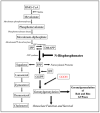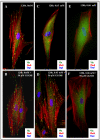Novel therapy to reverse the cellular effects of bisphosphonates on primary human oral fibroblasts
- PMID: 21807448
- PMCID: PMC3179815
- DOI: 10.1016/j.joms.2011.03.005
Novel therapy to reverse the cellular effects of bisphosphonates on primary human oral fibroblasts
Abstract
Purpose: Osteonecrosis of the jaws (ONJ) is a clinical condition that is characterized by a nonhealing breach in the oral mucosa resulting in exposure of bone and has been increasingly reported in patients receiving bisphosphonate (BP) therapy. Although the pathogenesis and natural history of ONJ remain ill-defined, it appears that the oral soft tissues play a critical role in the development of this condition. We examined the effects of the nitrogen-containing BPs pamidronate and zoledronate on primary human gingival fibroblasts.
Materials and methods: Primary gingival fibroblasts were exposed to clinically relevant doses of pamidronate and zoledronate. Cellular proliferation was measured with an MTS/PMS reagent-based kit (Promega, Madison, WI), scratch wound assays were performed to measure cellular migration, and apoptosis was measured by use of terminal deoxynucleotidyl transferase-mediated dUTP-FITC end labeling and caspase assays. The BP-exposed cells were treated with 10-ng/mL recombinant human platelet-derived growth factor BB (rhPDGF-BB) and 50-μmol/L geranylgeraniol (GGOH).
Results: Gingival fibroblasts are significantly more sensitive to inhibition of proliferation by zoledronate compared with pamidronate. Exposure of these cells to pamidronate but not zoledronate resulted in an increase in cellular apoptosis. Furthermore, exposure of gingival fibroblasts to pamidronate or zoledronate resulted in a decrease in cellular migration. We show that these defects are due to a loss of cell-substratum adhesion and a reduction of F-actin bundles. Finally, we show that the addition of rhPDGF-BB and GGOH in vitro is able to partially rescue the cell proliferation, migration, and adhesion defects.
Conclusion: The cytotoxic effects of BPs on oral fibroblasts and their significant reversal by the addition of GGOH and rhPDGF-BB provide both the potential mechanism and treatment options for ONJ.
Copyright © 2011 American Association of Oral and Maxillofacial Surgeons. Published by Elsevier Inc. All rights reserved.
Figures









Comment in
-
Comments on Novel Therapy to Reverse the Cellular Effects of Bisphosphonates on Primary Human Oral Fibroblasts by Cozin M et al (2011).J Oral Maxillofac Surg. 2012 Jan;70(1):3. doi: 10.1016/j.joms.2011.10.021. J Oral Maxillofac Surg. 2012. PMID: 22182654 No abstract available.
Similar articles
-
Inhibition of oral mucosal cell wound healing by bisphosphonates.J Oral Maxillofac Surg. 2008 May;66(5):839-47. doi: 10.1016/j.joms.2008.01.026. J Oral Maxillofac Surg. 2008. PMID: 18423269 Free PMC article.
-
The influence of bisphosphonates on viability, migration, and apoptosis of human oral keratinocytes--in vitro study.Clin Oral Investig. 2012 Feb;16(1):87-93. doi: 10.1007/s00784-010-0507-6. Epub 2011 Jan 12. Clin Oral Investig. 2012. PMID: 21225298
-
The influence of geranylgeraniol on human oral keratinocytes after bisphosphonate treatment: An in vitro study.J Craniomaxillofac Surg. 2015 Jun;43(5):688-95. doi: 10.1016/j.jcms.2015.03.014. Epub 2015 Mar 27. J Craniomaxillofac Surg. 2015. PMID: 25913629
-
Bisphosphonate-related osteonecrosis of the jaws: an update on clinical, pathological and management aspects.Head Neck Pathol. 2007 Dec;1(2):132-40. doi: 10.1007/s12105-007-0033-2. Epub 2007 Dec 5. Head Neck Pathol. 2007. PMID: 20614264 Free PMC article. Review.
-
[Bisphosphonate-associated osteonecrosis of the jaw].Mund Kiefer Gesichtschir. 2006 Mar;10(2):73-81. doi: 10.1007/s10006-005-0670-0. Mund Kiefer Gesichtschir. 2006. PMID: 16456688 Review. German.
Cited by
-
A Review Into the Effects of Pamidronic Acid and Zoledronic Acid on the Oral Mucosa in Medication-Related Osteonecrosis of the Jaw.Front Oral Health. 2022 Feb 9;2:822411. doi: 10.3389/froh.2021.822411. eCollection 2021. Front Oral Health. 2022. PMID: 35224540 Free PMC article. Review.
-
Synthetic Hydroxyapatite Inhibits Bisphosphonate Toxicity to the Oral Mucosa In Vitro.Materials (Basel). 2020 May 1;13(9):2086. doi: 10.3390/ma13092086. Materials (Basel). 2020. PMID: 32369961 Free PMC article.
-
In vitro Effect of Geranylgeraniol (GGOH) on Bisphosphonate-Induced Cytotoxicity of Oral Mucosa Cells.Front Oral Health. 2022 Jun 20;3:892615. doi: 10.3389/froh.2022.892615. eCollection 2022. Front Oral Health. 2022. PMID: 35795156 Free PMC article.
-
Effects of zoledronic acid and geranylgeraniol on the cellular behaviour and gene expression of primary human alveolar osteoblasts.Clin Oral Investig. 2016 Nov;20(8):2023-2035. doi: 10.1007/s00784-015-1706-y. Epub 2016 Jan 22. Clin Oral Investig. 2016. PMID: 26795621
-
The effects of ozone application on genotoxic damage and wound healing in bisphosphonate-applied human gingival fibroblast cells.Clin Oral Investig. 2018 Mar;22(2):867-873. doi: 10.1007/s00784-017-2163-6. Epub 2017 Jul 11. Clin Oral Investig. 2018. PMID: 28699091
References
-
- Colella G, Campisi G, Fusco V. American Association of Oral and Maxillofacial Surgeons position paper: Bisphosphonate-Related Osteonecrosis of the Jaws-2009 update: the need to refine the BRONJ definition. J Oral Maxillofac Surg. 2009;12:2698. - PubMed
-
- Khosla S, Burr D, Cauley J, et al. Bisphosphonate-associated osteonecrosis of the jaw: report of a task force of the American Society for Bone and Mineral Research. J Bone Miner Res. 2007;10:1479. - PubMed
-
- Kyle RA, Yee GC, Somerfield MR, et al. American Society of Clinical Oncology 2007 clinical practice guideline update on the role of bisphosphonates in multiple myeloma. J Clin Oncol. 2007;17:2464. - PubMed
-
- Patel V, McLeod NM, Rogers SN, et al. Bisphosphonate osteonecrosis of the jaw-a literature review of UK policies versus international policies on bisphosphonates, risk factors and prevention. Br J Oral Maxillofac Surg. 2010 - PubMed
-
- Ruggiero SL, Dodson TB, Assael LA, et al. American Association of Oral and Maxillofacial Surgeons position paper on bisphosphonate-related osteonecrosis of the jaws--2009 update. J Oral Maxillofac Surg. 2009;5(Suppl):2. - PubMed
Publication types
MeSH terms
Substances
Grants and funding
LinkOut - more resources
Full Text Sources

